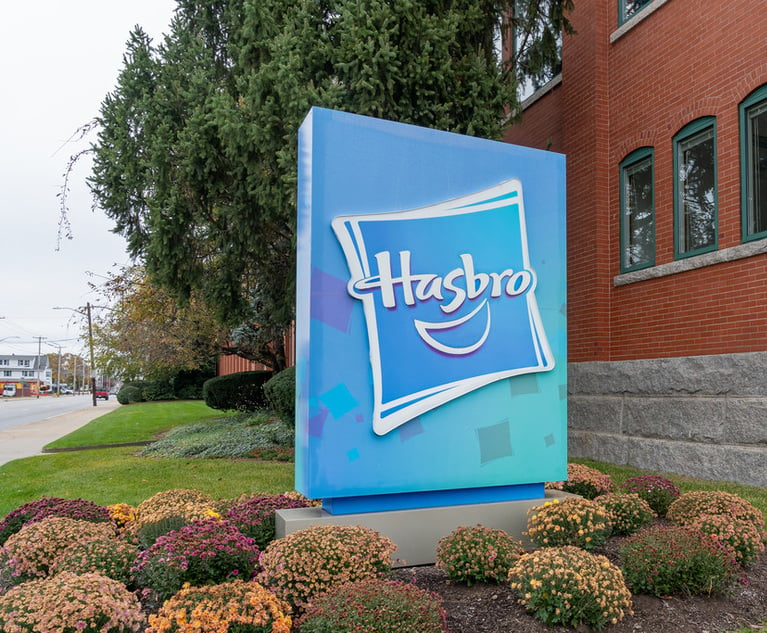Patently Obvious
Supreme Court reexamines standards for non-obviousness.
September 30, 2006 at 08:00 PM
7 minute read
The original version of this story was published on Law.com
The good news for KSR International Co. came in the middle of 2000 when General Motors tapped it to provide gas, brake and clutch pedal assemblies for its Chevrolet and GMC light truck lines. The contract was to commence with the 2003 model year.
It was a short-lived celebration at KSR. In Spring 2001 the Canadian company received a letter from rival parts manufacturer, Teleflex Inc. The Pennsylvania-based company claimed it owned a patent on the type of gas pedal that GM had hired KSR to supply. About a year later, Teleflex sued KSR for patent infringement.
KSR struck back, asking the court to invalidate Teleflex's patent because it covered a gas pedal that was obvious. The district court agreed. Judge Lawrence Zatkoff ruled in December 2003 that Teleflex's invention was just an obvious combination of two already existing pedal types.
But KSR's troubles weren't over. Teleflex appealed the decision, and the Federal Circuit reversed in January 2005, making KSR potentially liable to pay millions of dollars if it is found guilty of having provided GM with infringing pedals.
Now, the case is before the U.S. Supreme Court. And for the first time in 30 years, the High Court will rule on the standard that determines when an invention is obvious, and
thus ?? 1/2 unpatentable.
Most IP experts expect the High Court will toughen this standard, which may make it harder for companies to obtain patents. It also may cast doubt on the validity of existing patents.
“This case goes to the root of the patent system,” says Dale Heist, a patent attorney in the Philadelphia office of Woodcock Washburn. “[A]ll inventions are composed, at least in part, of prior inventions.”
In Hindsight
This case concerns two prior inventions. Adjustable pedals, which began appearing in cars during the 1970s, allowed drivers to position their pedals more comfortably. Pedals with electronic sensors began appearing in the mid-1990s. These pedals controlled the engine via electronic signals, rather than the traditional cable systems.
Teleflex invented neither pedal. It simply combined these two technologies and filed an application with the patent office. The office granted the company Patent No. 6,237,565, covering adjustable pedals with electronic sensors.
KSR argues the patent was invalid because the combination was not inventive; any automotive engineer would see the combination as obvious; and obvious inventions cannot be patented, according to Section 103(a) of the Patent Act. That provision mandates that an invention cannot be patented if, “at the time it was made,” it “would have been obvious ?? 1/2 to a person having ordinary skill in the art to which … [the invention] pertains.”
But was the Teleflex invention truly obvious? Even if combining the two types of pedals may seem obvious now, that doesn't mean it was obvious in August 2000, when Teleflex filed its application. “In hindsight, things frequently seem as if they should have been obvious at the time, but they weren't,” says George C. Best, a patent litigator in the Washington, D.C., office of Foley & Lardner.
That's why the Federal Circuit limits the use of hindsight. The court will find a combination of existing inventions to be obvious only if there was some reason for people at the time to combine those inventions. More specifically, there must be some contemporaneous “teaching, suggestion, or motivation” to combine the existing inventions.
A Bad Rule
Critics believe the Federal Circuit's rule favors patentees too much. They argue that even when a combination of existing inventions is obvious, it is often extremely difficult–or impossible–to locate any specific teaching, suggestion or motivation for the combination.
“In many cases, it would be so natural for a person of ordinary skill in the art to use two existing elements together ?? 1/2 that no one would think of articulating explicitly the kind of 'suggestion, teaching, or motivation' that the Federal Circuit requires,” Katherine Strandburg wrote in an amicus brief on behalf of herself and 23 other law professors in support of KSR. “Moreover, many aspects of ordinary skill ?? 1/2 are not likely to find their way into a written record ?? 1/2 because practitioners are motivated to publish novel applications of their arts, not routine applications.”
The result is that the patent office grants, and the courts uphold, patents on obvious and trivial alterations in existing technologies. “Over the years, the Federal Circuit has lowered the standard of obviousness ?? 1/2 allowing patents on obvious inventions,” says Rochelle Dreyfuss, who teaches patent law at New York University.
There's another difficulty with the Federal Circuit's test. It seems to contradict prior Supreme Court rulings.
The High Court has repeatedly stated that a patent cannot be granted for a so-called invention that merely combines known items with no change in their respective functions. A combination can be patented only if it produces a synergistic effect, where the whole is greater or different from the sum of its parts. The Court most recently affirmed this position in Sakraida v. Ag Pro Inc.
“The Federal Circuit ignores Sakraida,” says Strandburg, who teaches patent law at DePaul University. “It's not good to have the Federal Circuit saying the opposite of the Supreme Court.”
The Likely Outcome
Many patent experts anticipate the Supreme Court will use KSR to modify or eliminate the Federal Circuit's teaching-suggestion-motivation test. It's unclear what the new standard for obviousness might be, but the Court is expected to ratchet up this requirement–making it significantly easier for an invention to be found obvious, and thus unpatentable.
Such a ruling would hurt so-called “patent trolls” and others that assert rights based on dubious patents. Conversely, it would help companies that currently are assailed by a variety of questionable infringement suits. These defendants would have more leverage to attack plaintiffs' patents.
Consumers also would benefit, since patents would cover fewer products. “Things in the public domain could be gotten cheaper,” Dreyfuss says.
The ruling also may help researchers, many of whom are hampered by the need to obtain a multiplicity of patent licenses to do their work.
“For instance, a lot of genetic knowledge has been discovered through robotic techniques, and these genes have been patented,” Dreyfuss says. “If there was a higher standard of obviousness, so that a robot discovering something wasn't patentable, it would be very good for biological and medical research.”
Innovation overall may benefit. “Companies should direct more resources into nonobvious advances, rather than feeling they have to patent every obvious thing, or someone else will patent it,” Strandburg says.
When asked about the lawsuit and its ramifications, Teleflex and its counsel repeatedly failed to respond. On the other hand, KSR's counsel confidently predicted a victory in the High Court.
“The Solicitor General ?? 1/2 has said that Teleflex's patent is invalid,” says James Dabney, a litigator at Fried, Frank, Harris, Shriver & Jacobson. “The view of the Solicitor General ?? 1/2 is a good harbinger of where the Court will wind up.”
This content has been archived. It is available through our partners, LexisNexis® and Bloomberg Law.
To view this content, please continue to their sites.
Not a Lexis Subscriber?
Subscribe Now
Not a Bloomberg Law Subscriber?
Subscribe Now
NOT FOR REPRINT
© 2025 ALM Global, LLC, All Rights Reserved. Request academic re-use from www.copyright.com. All other uses, submit a request to [email protected]. For more information visit Asset & Logo Licensing.
You Might Like
View All
Recent Controversial Decision and Insurance Law May Mitigate Exposure for Companies Subject to False Claims Act Lawsuits
7 minute read

Trending Stories
- 1ACC CLO Survey Waves Warning Flags for Boards
- 2States Accuse Trump of Thwarting Court's Funding Restoration Order
- 3Microsoft Becomes Latest Tech Company to Face Claims of Stealing Marketing Commissions From Influencers
- 4Coral Gables Attorney Busted for Stalking Lawyer
- 5Trump's DOJ Delays Releasing Jan. 6 FBI Agents List Under Consent Order
Who Got The Work
J. Brugh Lower of Gibbons has entered an appearance for industrial equipment supplier Devco Corporation in a pending trademark infringement lawsuit. The suit, accusing the defendant of selling knock-off Graco products, was filed Dec. 18 in New Jersey District Court by Rivkin Radler on behalf of Graco Inc. and Graco Minnesota. The case, assigned to U.S. District Judge Zahid N. Quraishi, is 3:24-cv-11294, Graco Inc. et al v. Devco Corporation.
Who Got The Work
Rebecca Maller-Stein and Kent A. Yalowitz of Arnold & Porter Kaye Scholer have entered their appearances for Hanaco Venture Capital and its executives, Lior Prosor and David Frankel, in a pending securities lawsuit. The action, filed on Dec. 24 in New York Southern District Court by Zell, Aron & Co. on behalf of Goldeneye Advisors, accuses the defendants of negligently and fraudulently managing the plaintiff's $1 million investment. The case, assigned to U.S. District Judge Vernon S. Broderick, is 1:24-cv-09918, Goldeneye Advisors, LLC v. Hanaco Venture Capital, Ltd. et al.
Who Got The Work
Attorneys from A&O Shearman has stepped in as defense counsel for Toronto-Dominion Bank and other defendants in a pending securities class action. The suit, filed Dec. 11 in New York Southern District Court by Bleichmar Fonti & Auld, accuses the defendants of concealing the bank's 'pervasive' deficiencies in regards to its compliance with the Bank Secrecy Act and the quality of its anti-money laundering controls. The case, assigned to U.S. District Judge Arun Subramanian, is 1:24-cv-09445, Gonzalez v. The Toronto-Dominion Bank et al.
Who Got The Work
Crown Castle International, a Pennsylvania company providing shared communications infrastructure, has turned to Luke D. Wolf of Gordon Rees Scully Mansukhani to fend off a pending breach-of-contract lawsuit. The court action, filed Nov. 25 in Michigan Eastern District Court by Hooper Hathaway PC on behalf of The Town Residences LLC, accuses Crown Castle of failing to transfer approximately $30,000 in utility payments from T-Mobile in breach of a roof-top lease and assignment agreement. The case, assigned to U.S. District Judge Susan K. Declercq, is 2:24-cv-13131, The Town Residences LLC v. T-Mobile US, Inc. et al.
Who Got The Work
Wilfred P. Coronato and Daniel M. Schwartz of McCarter & English have stepped in as defense counsel to Electrolux Home Products Inc. in a pending product liability lawsuit. The court action, filed Nov. 26 in New York Eastern District Court by Poulos Lopiccolo PC and Nagel Rice LLP on behalf of David Stern, alleges that the defendant's refrigerators’ drawers and shelving repeatedly break and fall apart within months after purchase. The case, assigned to U.S. District Judge Joan M. Azrack, is 2:24-cv-08204, Stern v. Electrolux Home Products, Inc.
Featured Firms
Law Offices of Gary Martin Hays & Associates, P.C.
(470) 294-1674
Law Offices of Mark E. Salomone
(857) 444-6468
Smith & Hassler
(713) 739-1250






